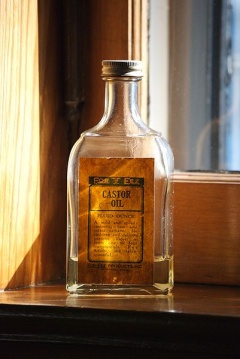Difference between revisions of "Castor Oil"
| Line 23: | Line 23: | ||
Favorable carrying temperature: 15°C<br> | Favorable carrying temperature: 15°C<br> | ||
Pumping temperature: 30° to 35°C<br> | Pumping temperature: 30° to 35°C<br> | ||
| − | Solidification temperature range: -10° to -18°C.<br><br> | + | Solidification temperature range: -10° to -18°C.<br> |
| + | Boiling point: 313°C<br><br> | ||
==Risk factors== | ==Risk factors== | ||
Revision as of 09:37, 14 June 2012
| Infobox on Castor Oil | |
|---|---|
| Example of Castor Oil |  |
| Facts | |
| Origin | This table shows only a selection of the most important countries of origin and should not be thought of as exhaustive.
|
| Density (in t/m3) | 0,950 - 0,968 |
| Temperature (in oC) | 12° to 25°C (see text) |
| Humidity / moisture | Fats and fatty oils are insoluble in water. |
| Ventilation | Ventilation must not be carried out under any circumstances. |
| Self-heating / spontaneous combustion | - |
| Risk factors | The oil may ignite spontaneously in conjunction with sawdust or material residues (see text). |
Castor Oil
Description
Castor oil is a yellow to yellow-brown oil produced by crushing castor seed. It is thick, has a high viscosity, and a nauseous smell and taste. Its solidifying point is very low. The product is exported in two grades:
- Cold pressed for the first grade of medicinal oil, containing below 1% of free fatty acid.
- Hot pressed commercial grade, containing not more than 2% free fatty acid.
Shipped in bulk, or in drums for small quantities. Castor oil is not liable to loss in weight or to deterioration through inherent vice. Proximity to boilers, combined with a long voyage, may result in an increase in the free fatty acid content. Drums/tanks must be free of rust and well cleaned before filling. If water is left in drums/tanks, the quality will deteriorate, and if the proportion of water is high, the oil will develop a smell similar to that of dirty water which has been stored for a long time. The quality of the oil must be examined by drawing samples for analysis. Rubbing a few drops of the oil between the palms of the hand, it gives at times a characteristic smell from which it may be possible to determine whether castor oil is in the process of deterioration, or in good condition.
Atmospheric oxygen, wetness and/or light can have an adverse influence on color, odor/taste (rancidity) and may cause gelling/thickening.
Applications
Castor oil is used in the food industry (additives, flavorings, mold inhibitor, packaging), grain preservative; in polyurethane; medicinal use; industrial use (cosmetics, pharmaceutical and manufacturing industries); as raw material for the production of a number of chemicals.
Shipment/storage
Storage duration of castor oil: approx. 6 months (at 12° to 25°C).
Favorable carrying temperature: 15°C
Pumping temperature: 30° to 35°C
Solidification temperature range: -10° to -18°C.
Boiling point: 313°C
Risk factors
- Self-heating / Spontaneous combustion
- Odor
- Contamination
- Mechanical influences
- Toxicity / Hazards to health
- Shrinkage/Shortage (tank wall adhesion up to 0.3% may be deemed normal).
Note:
(Source including Transport Information Service of the GDV)











